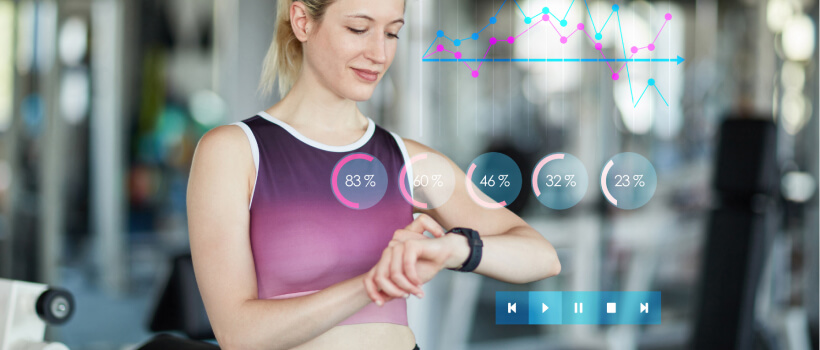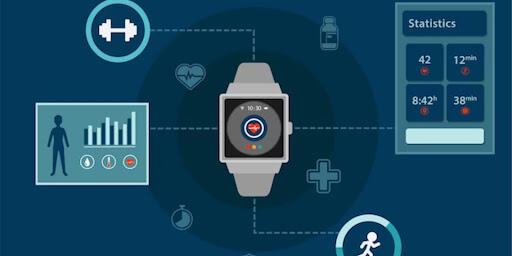 1-800-805-5783
1-800-805-5783 
In the era of digital transformation, wearable technology in healthcare has emerged as a transformative force, revolutionizing how we monitor and manage our health. These innovative devices, often called wearable medical devices, have gained immense significance in recent years. In this brief overview, we will explore the growing importance of wearable technology in healthcare, showcase some notable examples, and highlight its role in enhancing the quality of medical care.
Wearable technology in healthcare, also known as wearables, represents a category of electronic devices that can be worn on the body as accessories or clothing. These devices are equipped with sensors and connectivity features that enable them to collect and transmit data related to the wearer’s health and activity.
The integration of wearable technology into healthcare has opened up new possibilities for proactive health monitoring, disease management, and improved patient outcomes.

Many wearable technologies have evolved into medical-grade devices that provide healthcare professionals with valuable patient data. These wearable medical devices are increasingly used in clinical settings to monitor patients remotely, detect medical conditions earlier, and improve treatment outcomes. Examples include:
The growing significance of wearable technology in healthcare is undeniable. By seamlessly integrating data collection and analysis into our daily lives, wearables empower individuals to take charge of their health and well-being.
Moreover, healthcare providers can leverage this data to deliver more personalized and effective care, ultimately leading to better health outcomes and an enhanced quality of life for patients. As technology advances, we can expect wearable technology’s role in healthcare to expand even further, ushering in a new era of preventive and patient-centered medicine.

A. Improved Patient Engagement
1. Wearables encourage active involvement in health tracking
2. Enhanced patient-provider communication
B. Real-time Health Monitoring
1. Rapid detection of health issues
2. Timely interventions and prevention
C. Data Collection and Analysis
1. Gathering comprehensive health data
2. Utilizing big data for Healthcare Advancements
For instance, tiny, inconspicuous sensors embedded in clothing or accessories can now monitor heart rate and body temperature and even detect early signs of disease, providing continuous and precise insights into an individual’s health.
Example: Ultra-thin, skin-adhesive sensors that continuously monitor glucose levels for people with diabetes, ensuring real-time data accuracy without discomfort.
Example: Wearable ECG monitors that record and analyze heart rhythms, assisting cardiologists in identifying arrhythmias or heart abnormalities in their patients.
This enables the devices to identify real-time trends, anomalies, and potential health risks. AI-driven data analysis significantly enhances the accuracy and relevance of the information provided to patients and healthcare professionals.
Example: Smartwatches equipped with AI algorithms that analyze a user’s activity patterns and vital signs to detect subtle changes that may indicate the onset of a health issue.
Example: Wearable devices that predict asthma attacks by analyzing a patient’s breathing patterns and triggering alerts or medication recommendations when necessary.
Example: Remote patient monitoring systems that use wearable devices to track vital signs and share data with healthcare professionals in real-time for ongoing remote care.
Example: Wearable bright patches that track medication adherence and automatically notify healthcare providers if a patient misses a dose, ensuring seamless remote care management.

In conclusion, wearable technology in healthcare has emerged as a transformative force, revolutionizing how we monitor and manage our health. This innovative field is teeming with incredible wearable technology examples pushing the boundaries of what’s possible in healthcare.
Wearable medical devices have evolved beyond just tracking steps and heart rate; they now have the potential to provide real-time, life-saving data and personalized insights for patients and healthcare professionals alike.
As we’ve explored throughout this blog, wearable technology in healthcare offers numerous benefits, from early disease detection to remote patient monitoring, and it is poised to play a pivotal role in the future of healthcare.
Integrating wearable devices into our daily lives promises improved patient outcomes, reduced healthcare costs, and a more proactive approach to healthcare management.
Whether it’s smartwatches, fitness trackers, or specialized wearable medical devices, the wearable technology landscape is continuously evolving, promising exciting innovations on the horizon. These advancements underscore the immense potential of wearable technology in healthcare, highlighting the importance of staying informed and embracing these technologies to lead healthier lives.
In a world where data is king, wearable healthcare technology empowers individuals and healthcare professionals with the insights they need to make informed decisions about their well-being.
As we look ahead, it’s clear that wearable technology in healthcare will continue to be a driving force in the quest for healthier, more connected lives. Embracing these wearable innovations can pave the way for a brighter, more health-conscious future.
So, whether you’re intrigued by the latest wearable technology examples or seeking solutions from wearable medical devices, the future of healthcare is undoubtedly intertwined with the promise of wearable technology. Stay informed, explore the possibilities, and make the most of these remarkable advancements for a healthier tomorrow.